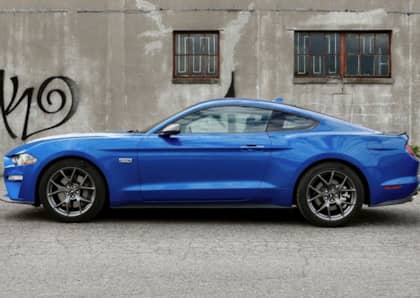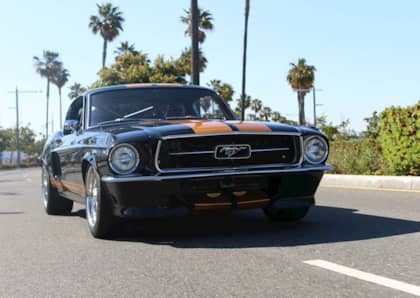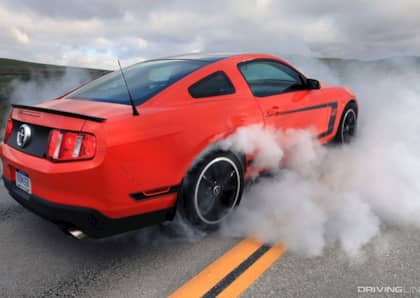2012-2013 Ford Mustang Boss 302 Was More Sports Car Than Muscle Machine
There have been so many special editions of the Ford Mustang that one can be forgiven for a little fatigue in that department. After all, this is the company that produced luminaries such as the 'California Special' (stickers) and the '7 Up Edition' (green paint and, uh, a white top), vehicles that didn't so much light the soul on fire as they did offer an upcharge opportunity for the sales team.

This means that sometimes truly unique versions of the car are overlooked rather than celebrated—particularly those that come near the end of a generation's run, obscured by a bigger, better, faster version that debuts just a few years later. Of these, there's no model in modern Mustang-land that's been denied its share of the spotlight more than the 2012-2013 Boss 302, a sports car disguised in a muscle car package, and the most compelling version of the live-axle platform ever built by Ford.
Race Car For The Street
Gearhead historians will instantly recognize the Boss 302 name as being originally applied to the road racing versions of the Mustang that competed in the Trans Am series at the end of the '60s and beginning of the '70s. The revival was no accident: Ford was keen to not just cash in on the heritage surrounding those stylish and successful street/track machines, but also demonstrate that the current car was capable of conquering more than just a drag strip.
It was somewhat of a tall order at the time. Although as popular as ever with buyers thanks to its mix of retro styling and V8 power, the Mustang's handling had never been its strongest suit, especially since abandoning a brief flirtation with independent rear suspension in its previous generation. The solid rear axle that sat underneath the S197 platform was routinely singled out as holding back the coupe on a road course.

Ford's engineers thought otherwise, and set out to prove it by building a thinly-disguised, limited production race car for the street. Starting with the suspension, the Boss 302 would gain new springs and bushings, sits nearly a half inch lower than a standard Mustang GT in the front, and offer 5-way adjustable shocks at all four corners. A larger 25mm rear stabilizer bar was installed, 19-inch rims (wide at the rear) were standard, and all of the car's electronic nannies were retuned to play nicer with competition-style shenanigans.
Under the hood, things also got serious. The GT's 5.0 V8 was revised with new cylinder heads, more aggressive camshafts, larger intake valves, and an entirely new intake manifold (sourced from the 302R race car). The entire rotating assembled was forged, bearings were borrowed from the Blue Oval's on-track program, and 8.5 quarts of oil could be loaded up into the Boss 302's baffled pan in order to prevent starvation in the corners.

The end result was 444 horsepower and 380 lb-ft of torque, with the former number representing a substantial upgrade over the GT's output. The character of the engine was also different, shunting power higher in the rev range with max grunt arriving at 7,500 rpm. A six-speed manual gearbox, LSD, and 3.73 rear gears were included with the car, and a Torsen locking differential could be added as an option.
Best of all? The Boss 302 came from the factory with sidepipes that dumped just ahead of the rear wheels. These were found in addition to the stock GT exhaust system, and used a set of plates to mute the sound to legal levels—plates that were easily removed to uncap the car's full fury.
Even more hardcore was the Laguna Seca edition of the car, which deleted the back seats in favor of additional chassis bracing, included the Torsen diff as standard, stiffened most of the car's suspension settings, and included Recaro sport seats.
Choose The Red Key
One of the most unique aspects of the Ford Mustang Boss 302 was the TracKey option. A second physical key (painted red) swapped the vehicle's ECU over to 'TracMode,' which altered 200 individual engine management settings outside of what the EPA would consider 'legal.' The end result? Ultra-sharp throttle response, better low-end torque, a two-stage launch control system, more aggressive engine deceleration and zero limits on power delivery compared to the street setting.

This was one of the first instances of a mainstream manufacturer deploying a dual-key setup to squeeze extra performance out of a vehicle. It was also perhaps the last time an OEM executive would be quoted as stating that the idea was to create a car that would appeal to the street racing crowd and hopefully end up on YouTube "doing something illegal."
Night And Day
Despite wearing an aero package lifted wholesale from the Boss 302R track beast, the Boss 302 is somewhat under the radar to the casual muscle car observer. A front splitter, side sills, and trunk splitter (bigger on the Laguna Seca) are all painted black, with a loud black reverse-C stripe framing the Boss 302 call-out on the fenders. Unique colors for the car included Competition Orange, Race Red, Kona Blue, Yellow Blaze Metallic Tri-Coat, Black, Ingot Silver, Grabber Blue, Gotta Have It Green, Performance White and School Bus Yellow.
From behind the wheel, however, the differences between the 302 and its GT sibling are impossible to ignore. The Boss dances where the GT plows, liberated from traditional pony car dynamics by its focused chassis tune and wide, sticky rubber. With the TracKey activated and an open track ahead of you, the Boss 302 is more sports car than muscle machine, each aspect of its character working together to create a cohesive, and immersive, high performance experience. In fact, it doesn't feel like a Mustang at all—high praise from an era when the S197 was still struggling to overdub its straight-line reputation with a bit of side-to-side panache.

More quantitative evaluations agree. Off the line the Boss 302 will hit 60-mph in just a tick over four seconds, and keep up with the much more powerful, yet not nearly as lithe Shelby GT500 of the era from a roll. The 302 also courts more regal company, matching a contemporary BMW M3 for speed in a number of measures.
(Almost) No Respect
Very few Ford Mustang Boss 302s were built during the car's two year run. Officially, the number was capped at 4,000 per year, including the even-rarer Laguna Seca editions, but overall 8,335 left the factory (of which 1,532 wore the name of the famous California race track).
The scarcity of the car no doubt feeds into its relatively subdued profile. There simply aren't many 302s out there, and with a shorter run than the Shelby (and less of a marketing machine behind them), it's easier for them to get lost in the wash. Throw in the debut of the phenomenally-capable S550 platform for the 2015 model year (and the Shelby GT350 model that followed), and the Boss falls further into obscurity.

Still, the 302 is an important car for many reasons. It was the first of the modern muscle triumvirate to make concessions towards road course performance, beating the resurrected Chevrolet Camaro 1LE to the punch by a full year. It led the way for Ford to engineer in better, smoother handling prowess into the S550 when it appeared, and it paid tribute to one of the most historically important Mustangs in company history with more than just a smattering of decals and a dash plaque. There's no doubt that the 2012-2013 Ford Mustang Boss 302 is one of, and perhaps the only Mustang built after the turn of the millennium to be a virtual lock as a future collector car.
Photography by Rachel Hunting
Curious about the history of the Boss 302's natural rival? Click here for everything you need to know about the Chevrolet Camaro 1LE.











